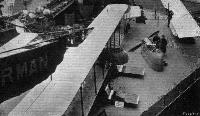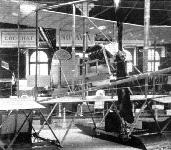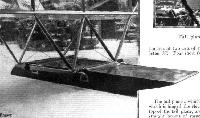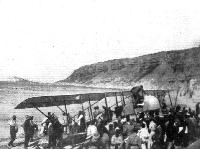В.Шавров История конструкций самолетов в СССР до 1938 г.
"Морис Фарман" поплавковый (гидроаэроплан Фармана) был двух типов: 1912 г. - с передним рулем высоты и 1914 г. - поплавковый вариант учебного самолета "Морис Фарман" с двигателем "Рено" в 70 л. с., потом 80 л. с. в обоих типах. Первый тип был в двух экземплярах на Балтике. Второй был куплен в 1914 г. в 20 экземплярах, которые и применялись в морской авиации на Балтике до 1917 г. Один самолет был взят в гидрографическую экспедицию Вилькицкого. На нем же 7-12 августа 1914 г. поручик Ян Иосифович Нагурский летал над Новой Землей в поисках экспедиции Г. Я. Седова. Это были первые полеты в Арктике.
Самолет|| учебный/ поплавковый
Год выпуска||1914/1913
Двигатель, марка||/
Мощность||80/70
Длина самолета, м||9,74/8,3
Размах крыла, м||16,1/13,2
Площадь крыла, м2||52,10/50
Масса пустого, кг||550/580
Масса топлива+ масла, кг||110/80
Масса полной нагрузки, кг||250/240
Полетная масса, кг||800/820
Удельная нагрузка на крыло, кг/м2||15,3/16,4
Удельная нагрузка на мощность, кг/лс||10,0/11,7
Весовая отдача, %||31/29
Скорость максимальная у земли, км/ч||90/90
Скорость посадочная, км/ч||55/60
Продолжительность полета, ч.||?/4
L.Opdyke French Aeroplanes Before the Great War (Schiffer)
Deleted by request of (c)Schiffer Publishing
MF 10: This handsome big seaplane was shown at the 1913 Salon in Paris, the first Maurice Farman with the single low-set tailplane and 2 triangular rudders set on top. The top wings overhung substantially, and there was no forward elevator.
(Length: 9.68 m; Renault)
Журнал Flight
Flight, December 13, 1913.
THE STANDS AT THE PARIS AERO SHOW.
FARMAN.
On the Farman stand are shown two complete machines, one is a M. Farman hydro-aeroplane without the front elevator. This machine has tail outriggers of a similar type to those of the land machine, of which illustrations were published in the columns of FLIGHT a short time ago. The other is a H. Farman of quite novel design, being what the Germans call a one and a half plane. The top plane and tail planes are similar to those of the standard type H. Farman, but the nacelle is placed immediately under the top plane, whilst a quite small lower plane is placed down almost on top of the chassis wheels. It will be interesting to see what this machine will do, as one imagines that it would have a very high centre of gravity, and thus be very sensitive to the controls, to say the least.
Flight, December 20, 1913.
THE PARIS AERO SALON - 1913.
FARMAN.
<...>
The other complete machine exhibited on the Farman stand is a M. Farman hydro-biplane Deauville type, fitted with a 70 h.p. Renault engine.
The nacelle, which has been raised considerably until the centre of thrust is now roughly half way between the planes, is of the ordinary M. Farman type as are also the pilot's and passenger's seats and the controls. It is bolted to the inner plane struts, which have a small ledge cut in them to act as support for the nacelle. The chassis consists of two sets of struts which in the front view resemble the letter W. Four short skids are attached to these struts, two to each set, and each float is slung from its two skids by rubber shock absorbers. The floats themselves are of the plain non-stepped type, and the whole chassis gives one the impression of being an immensely strong piece of work. The advantages of springing the floats have been pointed out in these columns so often, that repetition is unnecessary.
The tail planes, which now consist of a single fixed tail plane to which is hinged the elevator, and two rudders mounted wholly on top of the tail plane, are carried on an outrigger formed by four straight booms of spruce connected by hollow spruce struts. The angle of incidence of the fixed tail plane can be adjusted by means of a lock-nut working on a thread cut on the vertical tube which connects the upper and lower tail booms. Two tail floats support the tail planes when the machine is on the water, and the method of mounting these floats is shown in one of the accompanying sketches. Needless to say, the workmanship and finish is of the best quality, as is to be expected from so well known a firm as the Farman Brothers.











